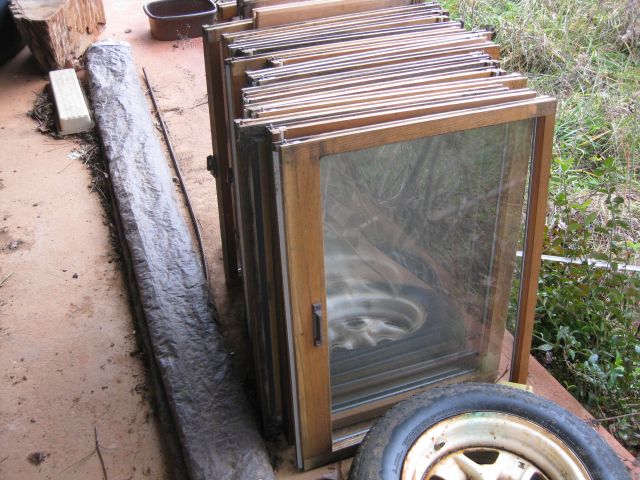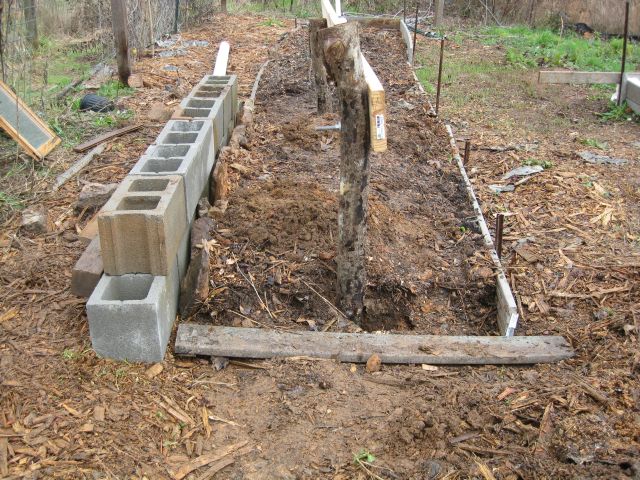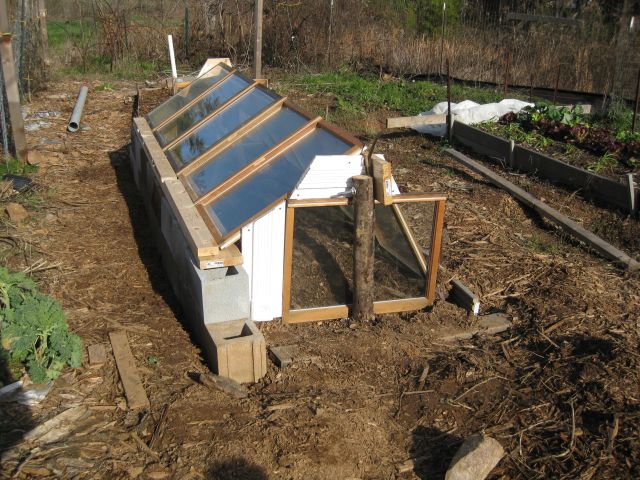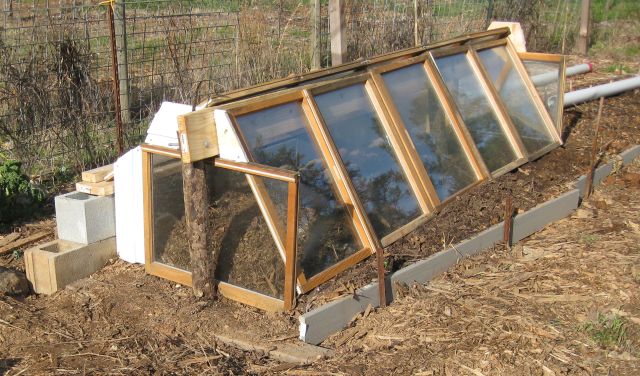On a recent visit to the thrift store, where there are often solid wood furniture and country painting bargains, I noticed about 50 double insulated small windows each 2 ft wide and 31″ high. Available for $1 each. I bought 22. And have spent a lot of time figuring how to use them effectively in a cold frame.

My greens are growing very well under an Agripon row cover – it allows air and rain through, protects against frost, keeps the temperature higher inside than out and allows some light through. However, as with most all solutions, there are negatives. The cover allows light through, but not all the light and it keeps temperatures higher than ambient temperatures, but not that much higher. This has worked fine up to now since temperatures have been mild. Temperatures in January and February will be much lower. A cold frame using glass windows will let much more light through and will keep temperatures much higher. Negatives are more labor intensive and costly to construct, does not allow rain to penetrate therefore more supplemental watering required and, on warm days, the temperature will rise too high so I shall have to be watchful to allow ventilation. An advantage of a cold frame over my greenhouse is the plants will be growing in the ground and their roots will penetrate further than in greenhouse pots.
So having rationalized the need for a cold frame I developed a simple construction plan requiring minimal additional expenditures.

I appropriated a section of a newly built raised bed, which has stones on the north side to store heat. I assembled a two level wall of cement blocks (8″x8″x16″ – $1.25 each). 9 blocks on the ground and 8 above them (not mortared). Most of the construction time was ensuring the bottom blocks were level. I recycled two cherry branches for my uprights to which I bolted a 2″x8″x10ft untreated plank ($5.85) which acts as the ridge on which the windows will rest.

Since cement blocks have cavities, I aligned a second 2″x8″x10ft plank along the top of the second block layer to which I screwed 5 right angle brackets which grip the inside face of the cement blocks to prevent the plank sliding off the blocks. Additionally I screwed a 2″x4″ plank along the left side of the plank as a step to prevent the windows sliding off the plank.

On the south side of the cold frame I have the 5 windows with bottom edges resting on the ground and top edge resting on the ridge line. A total of 12 windows were used, 5 facing up and north, 5 facing south and 1 on each end. By having the south windows and the end windows resting on the ground this will maximize exposure to the low southern sun (also, unfortunately, accelerate moisture penetration and wood rot). The areas not enclosed by the windows were filled with sized surplus lumber. For access and ventilation I remove the south facing windows. I placed an electronic min/max thermometer in the cold frame and tomorrow, hopefully, I will find there was reasonable heat retention. The ground should also have warmed up and I will plant out more of my kale, collard, mache, broccoli raab, and turnip greens seedlings.

end windows resting on the ground this will maximize exposure to the low southern sun (also, unfortunately, accelerate moisture penetration and wood rot).
You could lay down a piece of pressure treated wood. Wrap it in vapour barrier to stop any possible leaching of chemicals. We used to make our raised beds out of pine or spruce since cedar is extremely expensive here. We switched to pressure treated when we realized that the pine/spruce was rotting after three years. <a href="https://picasaweb.google.com/108665847651807187576/NewRaisedBedSoftFruits#5691711405781656466" We wrap all the pressure treated wood in vapour barrier to isolate it from the soil.
Regards,
Mike
Thanks Mike for helpful comment. I like your guild garden photos.
It’s probably more of a polyculture than a guild. Permaculture guilds have a more integrated, symbiotic design eg, Three Sisters. Any integration we had was more serendipitous than planned. What we planted was more as a result of space constraints. The fact that there were legumes fixing nitrogen and squash shading tree roots was an unplanned consequence. We were very pleased with the results and built on them this year. What surprised us was that we got such good results for so little prep work. The richness and friability of the soil this past spring was very noticeable in comparison to the surrounding soil. We should probably do a post comparing the two years.
Looking at the third picture of your cold frame, can any one of the five windows be removed without first having to remove other windows?
Regards,
Mike
I shall be planting the three sisters this spring and am growing seed for perennials to ensure a more diverse planting. Have you attended a pdc? There is only a sparse offering in the southeast, with most of the action in the northwest which is a different climate zone. Nasturtiums grow prolifically in San Francisco but mine only got going in September when much of the heat had passed, so if I attend a course in the northwest I shall have to translate a lot of the insights to my climate.
Access to the cold frame is via the windows in the fourth (last) photo – they move individually forward or can be removed, for weeding, watering, ventilation and harvesting. They are not directly exposed to wind from the north and may only come down if wind from the north creates a vacuum which pulls them over. No doubt I will find out.
Have you attended a pdc?
No, mostly because the price for two is more than we can afford. If we were going to spend the money, we can make far better use of it in the garden. I’m also a bit uncomfortable with its apparent formula-like approach. I see many people saying that they built their swale and they have their spiral herb garden so they’re making progress. Not every location needs a swale. Our herb garden isn’t a spiral and it is doing wonderfully well and looks fantastic. It’s a zone 1 planting but not because of any permaculture thinking but rather because some much older thinking – they were called kitchen herb gardens because they needed to be close to where the herbs were used. Having said that, I’m not really critical of permaculture. I think its concepts are well founded. We tend to cherry pick from it rather than try to implement it. A lot of what we do gets done when the garden talks to us and reveals what we could do next. This is essentially David Holmgren’s first of twelve design principles.
Your comment about having to translate a lot of the insights to your climate is a valid one. Most of the courses given seem to reflect the realities of tropical and semi-tropical environments. The examples used don’t work to well when you have an average January temperature of -14C like we do and a record January low of -38C. Food forests, another permaculture concept, are very seasonal here. That seasonality doesn’t seem to be a facet of permaculture. For us it’s not just a matter of getting a yield. Having the yield take us through to the next yield is critical. So food preservation techniques become as important as getting a yield. As far as I can tell, those techniques are not part of permaculture. If permaculture is a holistic, regenerative, and sustainable system, I think that they should be. Also seed saving techniques and plant propagation.
Regards,
Mike
I am absorbing permaculture from many sources – podcasts from permies and agroinnovations; just completed Gaia’s Garden and am working my way through Patrick White’s Earth Care Manual – both very well written and interesting. There are so many new dimensions to explore and, I agree, learning how to better observe and understand what I see, is key- one of the permies podcasts directed me, indirectly, to Tom Brown’s book “Tracker” which focuses on this facet and which I am enjoying. Thanks for your comments.
Regards,
Richard